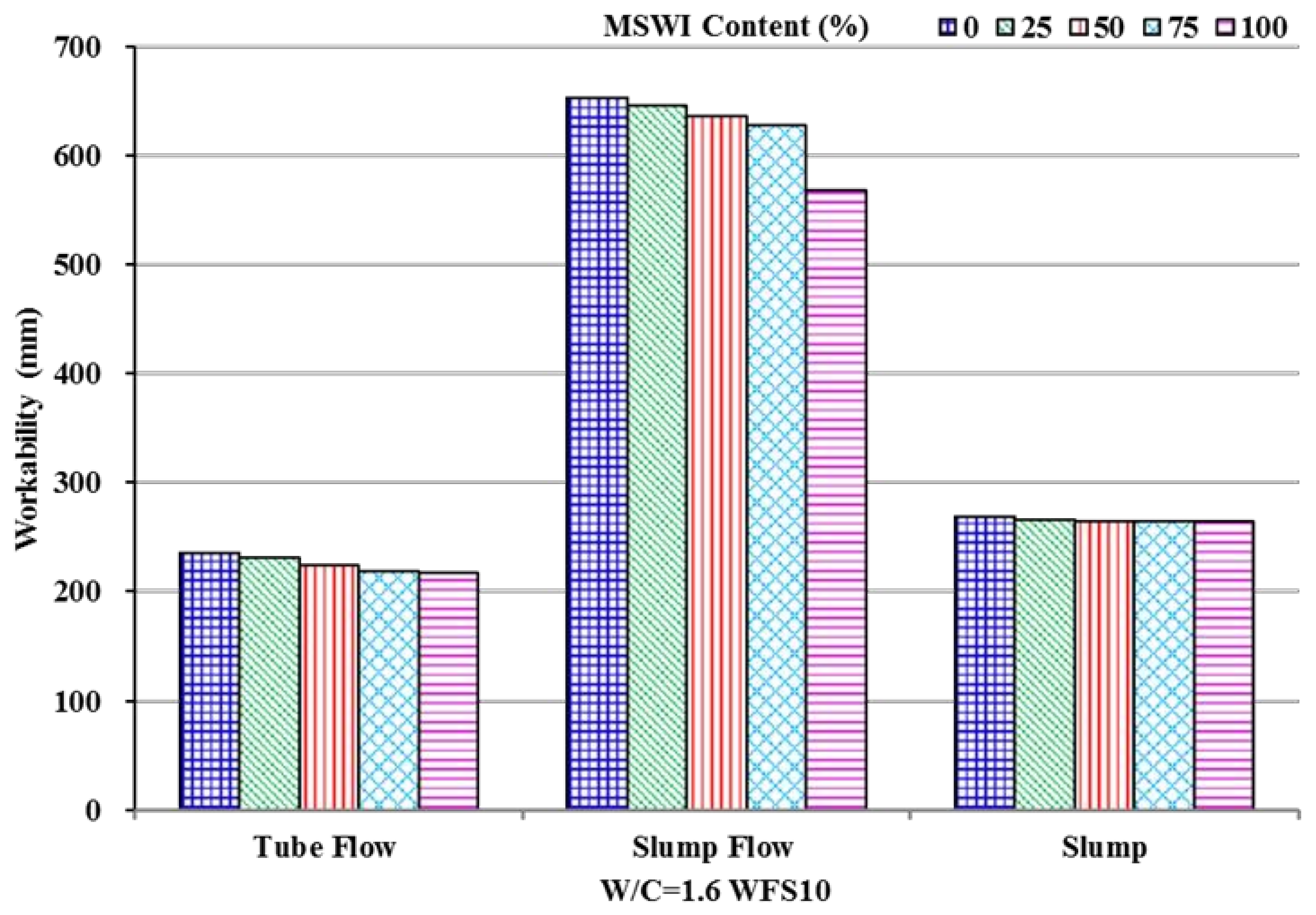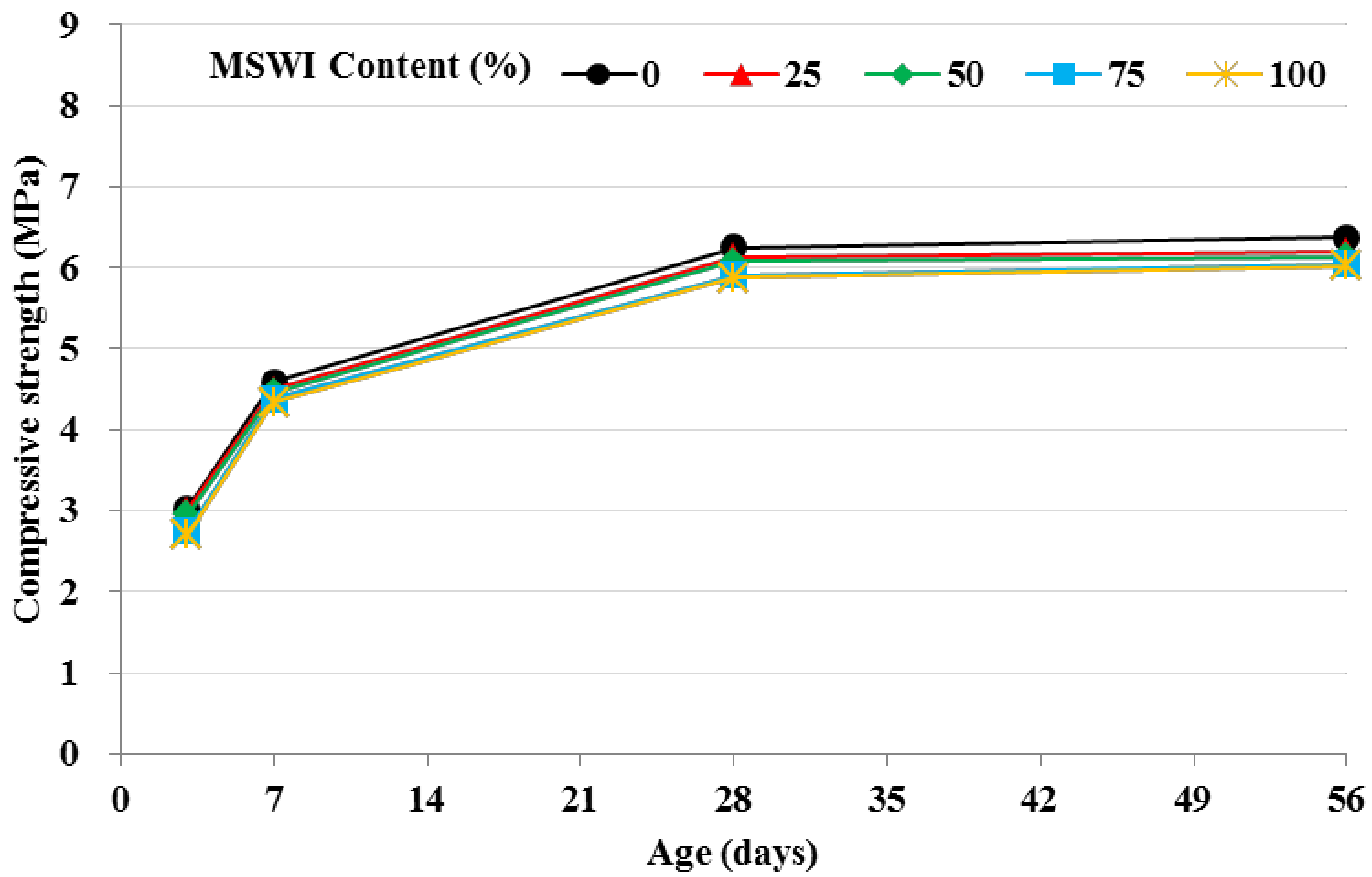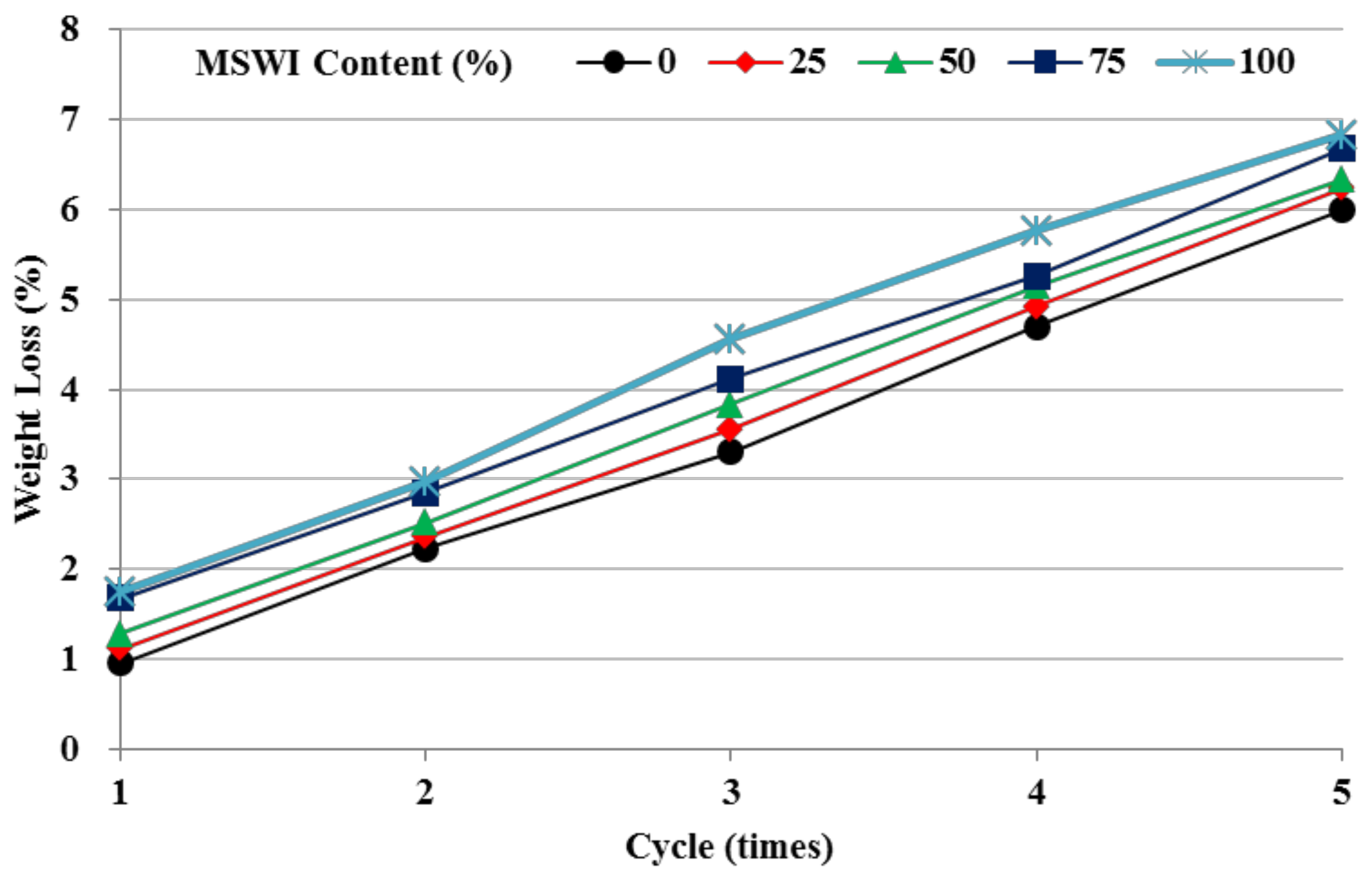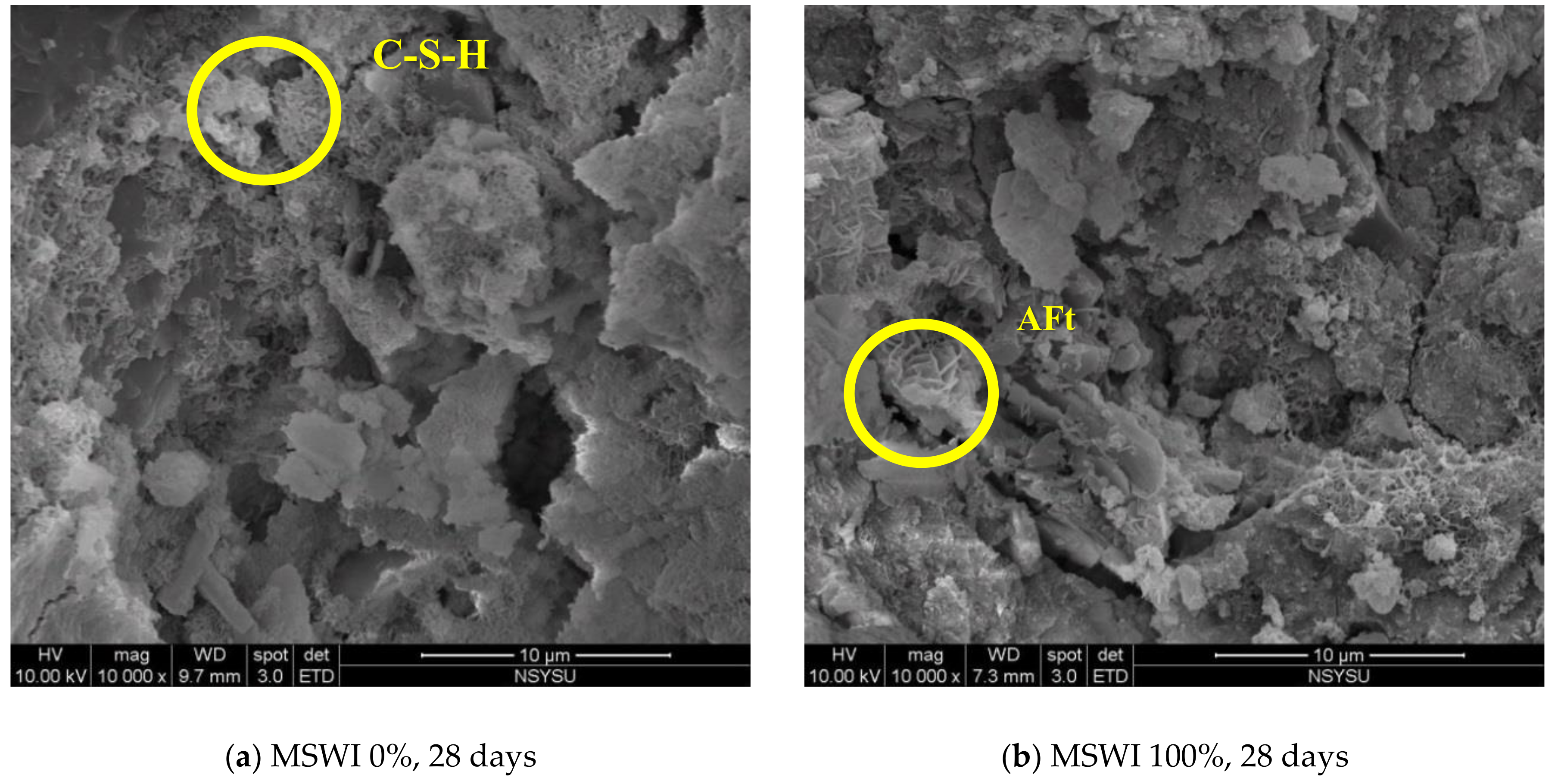Engineering Properties of Controlled Low-Strength Materials Containing Bottom Ash of Municipal Solid Waste Incinerator and Water Filter Silt
Abstract
:1. Introduction
2. Testing Methods
2.1. Materials
2.2. Mixture Proportion Design and Tests
3. Results and Discussion
3.1. Slump, Slump Flow, and Tube Flow
3.2. Penetration
3.3. Ball Drop
3.4. Compressive Strength
3.5. Ultrasonic Pulse Velocity
3.6. Water Absorption
3.7. Porosity
3.8. Sulfate Attack
3.9. Microscopic Interfacial Properties
4. Conclusions
- The slump, slump flow, and tube flow of the CLSM in the current study were 26.8–26.5 cm, 65.3–56.9 cm, and 23.5–21.7 cm, respectively. The slump flow and tube flow values of all of the mixture proportions were within the regulated range, indicating the favorable workability of CLSM.
- The control group reached the penetration value of 2.75 MPa the fastest (14.33 h). However, the time required to reach this value prolonged as the MSWI bottom ash replacement was increased.
- The value of the ball drop test was 5–5.9 cm, satisfying the regulation of ASTM D6024.
- To facilitate the subsequent excavation works in a construction process, the later-stage compressive strength of CLSM must be specified. The results of the current study showed that the compressive strength on Day 28 of curing was 6.25–5.87 MPa, satisfying the ASTM D4832 regulation of not exceeding 8.4 MPa. This result demonstrated that using recycled MSWI bottom ash in CLSMs is feasible.
- In the future, waste incineration bottom slag can be expanded and applied to ready-mixed soil materials for feasibility evaluation of related experiments.
Author Contributions
Funding
Acknowledgments
Conflicts of Interest
References
- Wiles, C.C. Municipal solid waste combustion ash: state-of-the-knowledge. J. Hazard. Mater. 1996, 47, 325–344. [Google Scholar] [CrossRef]
- Bosmans, A.; Vanderreydt, I.; Geysen, D.; Helsen, L. The crucial role of waste-to-energy technologies in enhanced landfill mining: a technology review. J. Clean. Prod. 2013, 55, 10–23. [Google Scholar] [CrossRef]
- Li, M.; Xiang, J.; Hu, S.; Sun, L.S.; Su, S.; Li, P.S.; Sun, X.X. Characterization of solid residues from municipal solid waste incinerator. Fuel 2004, 83, 1397–1405. [Google Scholar] [CrossRef]
- Garcia-Lodeiro, I.; Carcelen-Taboada, V.; Fernández-Jiménez, A.; Palomo, A. Manufacture of hybrid cements with fly ash and bottom ash from a municipal solid waste incinerator. Constr Build Mater. 2016, 105, 218–226. [Google Scholar] [CrossRef]
- Wang, X.X.; Li, A.M.; Zhang, Z.K. The effects of water washing on cement-based stabilization of MWSI fly ash. Procedia Environ. Sci. 2016, 31, 440–446. [Google Scholar] [CrossRef]
- Li, X.G.; Liu, Z.L.; Lv, Y.; Cai, L.X.; Jing, D.B.; Jing, W.G.; Jian, S.W. Utilization of municipal solid waste incineration bottom ash in autoclaved aerated concrete. Constr Build Mater. 2018, 178, 175–182. [Google Scholar] [CrossRef]
- Le, N.H.; Abriak, N.E.; Binetruy, C.; Benzerzour, M.; Nguyen, S.T. Mechanical behavior of municipal solid waste incinerator bottom ash: Results from triaxial tests. Waste Manag. 2017, 65, 37–46. [Google Scholar] [CrossRef] [PubMed]
- ACI 229R-13: Report Controlled Low Strength Materials, American Concrete Institute, Farmington Hill, MI, USA. Available online: https://standards.globalspec.com/std/1610102/aci-229r (accessed on 1 June 2013).
- Zhen, G.Y.; Zhao, Y.C. Pollution. In Pollution Control and Resource Recovery for Sewage Sludge; Elsevier: Amsterdam, The Netherlands, 2017; pp. 161–180. [Google Scholar]
- Razak, H.A.; Naganathan, S.; Hamid, S.N.A. Performance appraisal of industrial waste incineration bottom ash as controlled low-strength material. J. Hazard. Mater. 2009, 172, 862–867. [Google Scholar] [CrossRef] [PubMed]
- Rafat, S. Utilization of waste materials and by-products in producing controlled low-strength materials. Resour. Conserv. Recycl. 2009, 54, 1–8. [Google Scholar]
- Razak, H.A.; Naganathan, S.; Hamid, S.N.A. Controlled low-strength material using industrial waste incineration bootom ash and refined kaolin. Arab. J. Sci. Eng. 2010, 35, 53–67. [Google Scholar]
- Razak, H.A.; Naganathan, S.; Hamid, S.N.A. Effect of kaolin addition on the performance of controlled low-strength material using industrial waste incineration bottom ash. Waste Manag. 2010, 28, 848–860. [Google Scholar]
- Naganathan, S.; Razak, H.A.; Hamid, S.N.A. Effect of quarry dust addition on the performance of controlled low-strength material made from industrial waste incineration bottom ash. Int. J. Miner. Metall. Mater. 2012, 19, 536–541. [Google Scholar]
- Zhen, G.Y.; Zhou, H.Y.; Zhao, T.T.; Zhao, Y.C. Performance appraisal of controlled low-strength material using sewage sludge and refuse incineration bottom ash. Chin. J. Chem. Eng. 2012, 20, 80–88. [Google Scholar] [CrossRef]
- Naganathan, S.; Razak, H.A.; Hamid, S.N.A. Properties of controlled low-strength material made using industrial waste incineration bottom ash and quarry dust. Mater. Des. 2012, 33, 56–63. [Google Scholar] [CrossRef]
- Naganathan, S.; Razak, H.A.; Hamid, S.N.A. Corrosivity and leaching behavior of controlled low-strength material (CLSM) made using bottom ash and quarry dust. J. Environ. Manag. 2013, 128, 637–641. [Google Scholar] [CrossRef] [PubMed]
- Chiou, I.J.; Chen, C.H. Reuse of incinerated ash from industrial sludge-derived fuel. Constr. Build. Mater. 2013, 49, 233–239. [Google Scholar] [CrossRef]
- Yan, D.Y.S.; Tang, Y.; Lo, I.M.C. Development of controlled low-strength material derived from beneficial reuse of bottom ash and sediment for green construction. Constr. Build. Mater. 2014, 64, 201–207. [Google Scholar] [CrossRef]
- Etxeberria, M.; Ainchil, J.; Péreza, M.E.; Gonzáleza, A. Use of recycled fine aggregates for Control Low Strength Materials (CLSMs) production. Constr. Build. Mater. 2014, 44, 142–148. [Google Scholar] [CrossRef]
- Kuo, W.T.; Wang, H.Y.; Shu, C.Y.; Su, D.S. Engineering properties of controlled low-strength materials containing waste oyster shells. Constr. Build. Mater. 2013, 46, 128–133. [Google Scholar] [CrossRef]
- Sheen, Y.N.; Huang, L.J.; Wang, H.Y.; Le, D.H. Experimental study and strength formulation of soil-based controlled low-strength material containing stainless steel reducing slag. Constr. Build. Mater. 2014, 54, 1–9. [Google Scholar] [CrossRef]
- Sheen, Y.N.; Zhang, L.H.; Le, D.H. Engineering properties of soil-based controlled low-strength materials as slag partially substitutes to Portland cement. Constr. Build. Mater. 2013, 48, 822–829. [Google Scholar] [CrossRef]
- Lee, N.K.; Kim, H.K.; Park, I.S.; Lee, H.K. Alkali-activated, cementless, controlled low-strength materials (CLSM) utilizing industrial by-products. Constr. Build. Mater. 2013, 49, 738–746. [Google Scholar] [CrossRef]
- Lachemi, M.; Sahmaran, M.; Hossain, K.M.A.; Lotfy, A.; Shehata, M. Properties of controlled low-strength materials incorporating cement kiln dust and slag. Cem. Concr. Compos. 2010, 32, 623–629. [Google Scholar] [CrossRef]
- ASTM C150, Standard Specification for Portland Cement, ASTM International, West Conshohocken, PA. Available online: https://www.astm.org/Standards/C150.htm (accessed on 1 April 2018).
- ASTM C143/C143M-15a, Standard Test Method for Slump of Hydraulic Cement Concrete, ASTM International, West Conshohocken, PA. Available online: https://www.astm.org/Standards/C143.htm (accessed on 15 December 2015).
- ASTM D6103. Standard Test Method for Flow Consistency of Controlled Low Strength Material (CLSM), ASTM International, West Conshohocken, PA. Available online: https://www.astm.org/Standards/D6103.htm (accessed on 1 November 2017).
- ASTM C403. Standard Test Method for Time of Setting of Concrete Mixtures by Penetration Resistance, ASTM International, West Conshohocken, PA. Available online: https://www.astm.org/Standards/C403.htm (accessed on 1 October 2016).
- ASTM D6024. Standard Test Method for Ball Drop on Controlled Low Strength Material (CLSM) to Determine suitability for Load Application, ASTM International, West Conshohocken, PA. Available online: https://www.astm.org/Standards/D6024.htm (accessed on 1 December 2016).
- ASTM D4832. Standard Test Method for Preparation and Testing of Controlled Low Strength Material (CLSM) Test Cylinders, ASTM International, West Conshohocken, PA. Available online: https://www.astm.org/Standards/D4832.htm (accessed on 15 December 2016).
- ASTM C597. Standard Test Method for Pulse Velocity Through Concrete, ASTM International, West Conshohocken, PA, (accessed on 1 16). Available online: https://www.astm.org/Standards/C597.htm (accessed on 1 April 2016).
- ASTM C642. Standard Test Method for Density, Absorption, and Voids in Hardened Concrete, ASTM International, West Conshohocken, PA. Available online: https://www.astm.org/Standards/C642.htm (accessed on 1 February 2013).
- ASTM C373. Standard Test Method for Water Absorption, Bulk Density, Apparent Porosity, and Apparent Specific Gravity of Fired Whiteware Products, Ceramic Tiles, and Glass Tiles, ASTM International, West Conshohocken, PA. Available online: https://www.astm.org/Standards/C373.htm (accessed on 1 February 2018).
- ASTM C1012. Standard Test Method for Length Change of Hydraulic Cement Mortars Exposed to A Sulfate Solution, ASTM International, West Conshohocken, PA. Available online: https://www.astm.org/Standards/C1012.htm (accessed on 1 February 2018).
- Wu, H.; Huang, B.; Shu, X.; Yin, J. Utilization of solid wastes/byproducts from paper mills in Controlled Low Strength Material (CLSM). Constr. Build. Mater. 2016, 118, 155–163. [Google Scholar] [CrossRef]








| Properties | Sand | MSWI | WFS |
|---|---|---|---|
| Specific gravity (OD) | 2.573 | 2.002 | 2.561 |
| Water absorption (%) | 2.564 | 11.179 | - |
| Moisture content (%) | 2.05 | 4.25 | 44.5 |
| Fineness modulus (FM) | 2.979 | 2.86 | - |
| Chemical Compositions (%) | Cement | MSWI | WFS |
|---|---|---|---|
| SiO2 | 20.87 | 24.84 | 23.49 |
| Al2O3 | 4.56 | 8.42 | 8.19 |
| Fe2O3 | 3.44 | 30.63 | 18.18 |
| CaO | 63.14 | 27.8 | 38.8 |
| MgO | 2.82 | 1.5 | 1.7 |
| W/C | NO. | Cement | Sand | Water | MSWI | WFS | |
|---|---|---|---|---|---|---|---|
| 1.6 | WFS10 | M0 | 218.9 | 1378.9 | 350.2 | - | 148.6 |
| M25 | 1034.1 | 292.1 | |||||
| M50 | 689.4 | 584.2 | |||||
| M75 | 344.7 | 876.3 | |||||
| M100 | - | 1168.4 | |||||
© 2018 by the authors. Licensee MDPI, Basel, Switzerland. This article is an open access article distributed under the terms and conditions of the Creative Commons Attribution (CC BY) license (http://creativecommons.org/licenses/by/4.0/).
Share and Cite
Kuo, W.-T.; Gao, Z.-C. Engineering Properties of Controlled Low-Strength Materials Containing Bottom Ash of Municipal Solid Waste Incinerator and Water Filter Silt. Appl. Sci. 2018, 8, 1377. https://doi.org/10.3390/app8081377
Kuo W-T, Gao Z-C. Engineering Properties of Controlled Low-Strength Materials Containing Bottom Ash of Municipal Solid Waste Incinerator and Water Filter Silt. Applied Sciences. 2018; 8(8):1377. https://doi.org/10.3390/app8081377
Chicago/Turabian StyleKuo, Wen-Ten, and Zhen-Chang Gao. 2018. "Engineering Properties of Controlled Low-Strength Materials Containing Bottom Ash of Municipal Solid Waste Incinerator and Water Filter Silt" Applied Sciences 8, no. 8: 1377. https://doi.org/10.3390/app8081377




